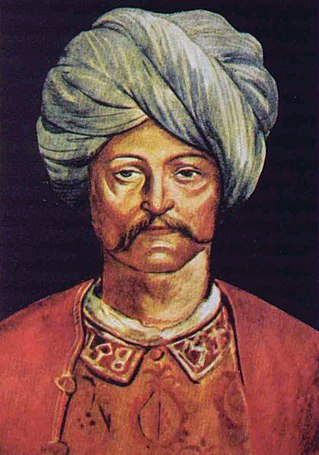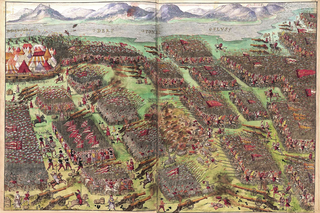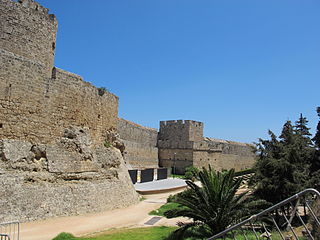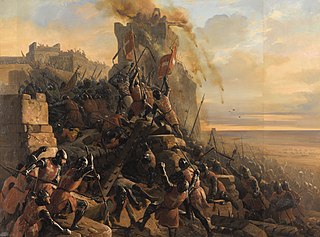
Cem Sultan or Sultan Cem or Şehzade Cem, was a claimant to the Ottoman throne in the 15th century.

Pierre d'Aubusson was a Grand Master of the Order of Saint John of Jerusalem, and a zealous opponent of the Ottoman Empire.

The Great Siege of Malta occurred in 1565 when the Ottoman Empire attempted to conquer the island of Malta, then held by the Knights Hospitaller. The siege lasted nearly four months, from 18 May to 12 September 1565.

Peter I was King of Cyprus and titular King of Jerusalem from his father's abdication on 24 November 1358 until his death in 1369. He was invested as titular Count of Tripoli in 1346. As King of Cyprus, he had some military successes, but he was unable to complete many of his plans due to internal disputes that culminated in his assassination at the hands of three of his knights.

The siege of Rhodes of 1522 was the second and ultimately successful attempt by the Ottoman Empire to expel the Knights of Rhodes from their island stronghold and thereby secure Ottoman control of the Eastern Mediterranean. The first siege in 1480 had been unsuccessful. Despite very strong defenses, the walls were demolished over the course of six months by Turkish artillery and mines.

In the summer of 1480, the Ottoman Empire invaded southern Italy, and laid siege to Otranto, finally capturing on 11 August. This was their first outpost in Italy. According to a traditional account, more than 800 inhabitants were beheaded after the city had been captured. The Martyrs of Otranto are still celebrated in Italy. A year later, the Ottoman garrison surrendered the city after a siege by Christian forces, uncertainty upon the death of sultan Mehmed II and the intervention of papal forces that were led by Paolo Fregoso of Genoa.

The history of Rhodes under the Order of Saint John lasted from 1310 until 1522. The island of Rhodes was a sovereign territorial entity of the Knights Hospitaller who settled on the island from Palestine and from Cyprus, where they did not exercise temporal power. The first Grand Master was the French Foulques de Villaret (1305–1319).

The Ottoman–Hungarian Wars were a series of battles between the Ottoman Empire and the medieval Kingdom of Hungary. Following the Byzantine Civil War, the Ottoman capture of Gallipoli, and the decisive Battle of Kosovo, the Ottoman Empire was poised to conquer the entirety of the Balkans and also sought and expressed desire to expand further north into Central Europe beginning with the Hungarian lands.

The First Ottoman–Venetian War was fought between the Republic of Venice with its allies and the Ottoman Empire from 1463 to 1479. Fought shortly after the capture of Constantinople and the remnants of the Byzantine Empire by the Ottomans, it resulted in the loss of several Venetian holdings in Albania and Greece, most importantly the island of Negroponte (Euboea), which had been a Venetian protectorate for centuries. The war also saw the rapid expansion of the Ottoman navy, which became able to challenge the Venetians and the Knights Hospitaller for supremacy in the Aegean Sea. In the closing years of the war, however, the Republic managed to recoup its losses by the de facto acquisition of the Crusader Kingdom of Cyprus.

Gabriel de Luetz, Baron et Seigneur d'Aramon et de Vallabregues, often also abbreviated to Gabriel d'Aramon, was the French Ambassador to the Ottoman Empire from 1546 to 1553, in the service first of Francis I, who dispatched him to the Ottoman Empire, and then of the French king Henry II. Gabriel de Luetz was accompanied by a vast suite of scientists, Jean de Monluc, philosopher Guillaume Postel, botanist Pierre Belon, naturalist Pierre Gilles d'Albi, the future cosmographer André Thévet, traveler Nicolas de Nicolay who would publish their findings upon their return to France and contribute greatly to the development of early science in France.
John Caius or Kay, sometimes called the elder,, was an English poet.

The fortifications of the town of Rhodes are shaped like a defensive crescent around the medieval town and consist mostly of a fortification composed of a huge wall made of an embankment encased in stone, equipped with scarp, bastions, moat, counterscarp and glacis. The portion of fortifications facing the harbour is instead composed of a crenellated wall. On the moles, towers and defensive forts are found.

The siege of Novo Brdo was a military blockade of Novo Brdo, an important fortified mining town in the Serbian Despotate, by the forces of the Ottoman Empire. The siege began in 1440 and lasted until the capture of the fortress on 27 June 1441. During the siege, the Serbian garrison was supported by the local community of citizens of the Republic of Ragusa.

The Hospitaller conquest of Rhodes took place in 1306–1310. The Knights Hospitaller, led by Grand Master Foulques de Villaret, landed on the island in summer 1306 and quickly conquered most of it except for the city of Rhodes, which remained in Byzantine hands. Emperor Andronikos II Palaiologos sent reinforcements, which allowed the city to repel the initial Hospitaller attacks, and persevere until it was captured on 15 August 1310. The Hospitallers transferred their base to the island, which became the centre of their activities until it was conquered by the Ottoman Empire in 1522.
The Battle of Pallene occurred in 1344 between the fleets of a Latin Christian league and Turkish raiders, at the Pallene Peninsula in northern Greece.

The siege of Rhodes was a military engagement involving the Knights Hospitaller and Mamluk Sultanate. The Mamluk fleet landed on the island of Rhodes on 10 August 1444, besieging its citadel. Clashes took place on the western walls of the city and at the Mandraki harbor. On 18 September 1444, the Mamluks departed from the island and lifted the siege.
The Battle of Imbros occurred in spring 1347 between the fleets of a Christian naval league formed as part of the Smyrniote crusades, and of a Turkish raiding fleet, possibly from the beyliks of Aydin and Sarukhan. The Turks abandoned their ships and landed on the island of Imbros, where most were captured.

Guillaume Caoursin, also called Gulielmus Caoursin, was vice-chancellor of the Order of Saint John of Jerusalem, or Knights Hospitaller. He was an eye-witness to the siege of Rhodes in 1480, an unsuccessful attack on the Hospitaller garrison led by Pierre d'Aubusson by an Ottoman fleet of 160 ships and an army of 70,000 men under the command of admiral Mesih Pasha.

The siege of Navarino was a military engagement between the Holy League fleet led by John of Austria who besieged the Ottoman garrison in Navarino. The siege ended in failure and the withdrawal of the Christian Armada.























